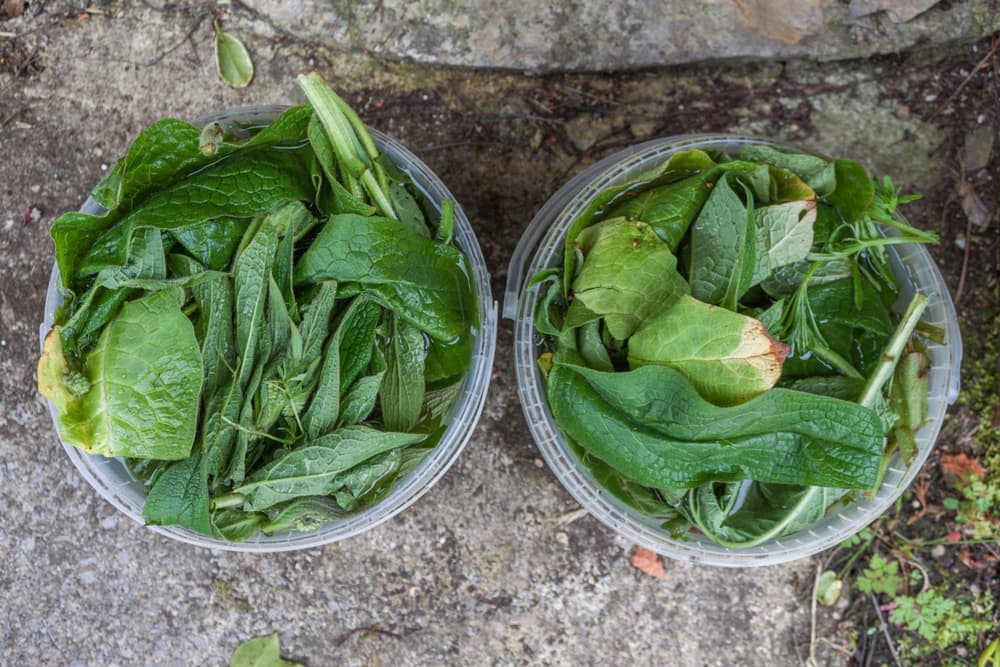Turn Your Comfrey Leaves Into A Fertiliser ‘Tea’ And Feed Plants Organically

PERENNIALS > COMFREY > TEA-FERTILISER

Elizabeth is a Permaculture Garden Designer, Sustainability Consultant and Professional Writer, working as an advocate for positive change. She graduated from the University of St. Andrews with an MA in English and Philosophy and obtained a Diploma in Applied Permaculture Design from the Permaculture Association.
Reviewed By DAN ORI

Dan has over 27 years’ under his belt caring for plants and gardens. Working as a Horticultural Instructor and Consultant, he draws on a diverse range of experience that includes working as a Head Gardener, Tree Surgeon, Garden Centre Trouble Shooter, and writer of academic papers. Dan has a Level 3 Diploma in Horticulture and is currently a candidate for the RHS’s most prestigious award – The Master of Horticulture.
Contributions From TAMSIN WESTHORPE

Tamsin Westhorpe is the Director and Head Gardener at Stockton Bury Gardens, a Judge at the RHS Chelsea Flower Show and a published Author - with 'Diary of a Modern Country Gardener' and 'Grasping the Nettle' amongst her most notable works. Tamsin is also Editor of the HTA magazine 'Inside Horticulture'.
IN THIS GUIDE
COMFREY GUIDES
Comfrey vs Borage
Fertiliser
– For Tomatoes
Growing From Seed
Harvesting
Root Cuttings
Varieties
Comfrey is a ubiquitous plant in sustainable gardening, used in a wide range of different ways.
One thing it is especially useful for is making a comfrey fertiliser, or liquid feed.
Comfrey is an extremely useful plant, both when growing in the garden, and when chopped and used.

In this guide we’ll explain exactly how you can maintain fertility in your garden and keep your plants happy by making a comfrey fertiliser or ‘comfrey tea’ to feed your plants in an organic, eco-friendly way.
Before we do – it is worth exploring briefly exactly why comfrey is such a useful plant to grow in your garden; the benefits it can bring for you, wildlife with whom you share your garden, your garden soil and your plants.
Why Grow Comfrey?

There are a huge range of reasons why comfrey is such a useful plant to grow:
- Comfrey grows quickly, producing an abundance of organic material. That material can be used as a mulch and soil amendment.
- It can be used in the creation of no-dig garden beds, added to a compost heap, or, of course, used to make a liquid plant feed.
- Their quick growth and effective ground cover means that they can be good for stopping the ingress of grasses or weeds into areas where you do not want them.
- Comfrey plants don’t just grow quickly, they also have very deep tap roots which means that they are very effective ‘dynamic accumulators’. In other words, they are good at taking up nutrients from the soil (we’ll explore this more below).1Zarro, G. (2020, July 20). Breaking Ground with Dynamic Accumulators. Cornell Small Farms. Retrieved March 14, 2023, from https://smallfarms.cornell.edu/2020/07/breaking-ground-with-dynamic-accumulators/
- When the plant materials are gathered and used, or the plants die back naturally in winter, those nutrients return to the soil and can be taken up by other plants.
- When comfrey is in flower, they are beloved by bees and other insects. Of course, bees and other pollinators are essential visitors for many of the crops and other plants we grow.
- Other insects attracted to comfrey can also help in keeping pest numbers down – comfrey is a great plant for organic pest control.2Comfrey: Its History, Uses & Benefits. (2022, June 30). Permaculture. Retrieved March 14, 2023, from https://www.permaculture.co.uk/articles/comfrey-its-history-uses-benefits/
- This plant is also a great addition to the diets of backyard chickens and other livestock.
What Makes It A Good Fertiliser?

Comfrey is, as mentioned above, great at gathering nutrients.3Comfrey Fact Sheet. (n.d.). Aeronvale Allotments. Retrieved March 14, 2023, from https://aeronvale-allotments.org.uk/downloads/Comfrey_factsheet-01.pdf
It draws up nutrients through its deep roots and stores them in a more bioavailable form.
It is this characteristic which makes comfrey great for use as a fertiliser.
The nutrients can be harnessed by chopping and dropping the material a couple of times over the growing season.

These can either be used as mulch or an ingredient in composting systems or raised beds – where the materials will break down pretty quickly.
Or they can be used to make a liquid fertiliser to give certain plants a boost.
“I’ve always made a lot of comfrey and nettle feeds,” shares Author and Gardener Tamsin Westhorpe.
“This is definitely worth doing as long as you can stand the smell of rotting foliage!”
Comfrey (all parts of the plant) contain the three key nutrients required for plant growth: nitrogen, phosphorus and potassium (NPK).4Comfrey. (2023, January 10). Garden Organic. Retrieved March 14, 2023, from https://www.gardenorganic.org.uk/expert-advice/garden-management/soil/comfrey

Comfrey is said, in particular, to be a good dynamic accumulator of potassium, though it typically also includes plenty of other micro-nutrients in smaller amounts.
The exact NPK profile of comfrey will depend on where it is grown, but a mulch or liquid feed made with this plant will be rich in potassium, which makes it particularly beneficial for flowering and fruiting plants.
Potassium is important for plants in maintaining their lifecycles and it is especially important during phases of reproduction.5Potassium for crop production. (n.d.). University of Minnesota. Retrieved March 14, 2023, from https://extension.umn.edu/phosphorus-and-potassium/potassium-crop-production
How To Make Comfrey Tea Fertiliser

The first step in making a comfrey tea fertiliser is, of course, choosing and planting your comfrey.
One of the most commonly used types of comfrey in gardens in the UK is called Symphytum x uplandicum (Russian comfrey) ‘Bocking 14’.6A survey of comfrey use. (2022, November 15). Garden Organic. Retrieved March 14, 2023, from https://www.gardenorganic.org.uk/what-we-do/citizen-science-and-research/members-experiments/a-survey-of-comfrey-use
This is a sterile cultivar developed in the 1950s by Lawrence Hills, who founded the Henry Doubleday Research Association.7Comfrey. (n.d.). Google Books. Retrieved March 14, 2023, from https://books.google.co.uk/books/about/Comfrey.html?id=HWTEOQAACAAJ&redir_esc=y
We do recommend that you choose a sterile cultivar since comfrey, though useful, can easily spread, and wherever it grows, it can be difficult to eradicate due to its deep roots.8Comfrey – A Controversial Herb. (n.d.). Master Gardener. Retrieved March 14, 2023, from https://www.mastergardenersmecklenburg.org/comfrey—a-controversial-herb.html

Comfrey is a hardy plant, which can grow well in many gardens with very different conditions.
For best results, it should be grown in a sunny or partially shaded or dappled shade site in deep, rich soil.
Comfrey is typically harvested for a liquid feed twice in the growing season – once in June, and again in August.
The comfrey can simply be chopped down, or mowed.

Remember, however, while harvesting, that it may be beneficial to keep some flowering for the wildlife in your garden.
Next you should:
- Chop the comfrey leaves, stems (and flowers where these have emerged) into smaller pieces, which will break down more quickly.
- Prepare a large bucket, barrel or other receptacle in which to make your liquid feed. It can be beneficial to choose a container which has a tap near the base, so you can draw off the liquid. It should also have a lid, since the comfrey tea will get very smelly!
- Fill the container with the chopped up comfrey leaves, packing them down to cram in as many as you can.
- Cover the comfrey with water, placing something on top to hold down the plant material. Then be sure to put the lid back on the container.
- Next, simply wait until the plant materials rot down into the water. This should take around 4-6 weeks.
How To Use Comfrey Feed

Run off the slurry and dilute it with water at a ratio of ten parts water to one part of this mix.
This will give you a liquid fertiliser that will not be too strong for your plants.
You can use this when watering your plants – I tend to fill a watering can with 1/3 of diluted comfrey tea with 2/3 water and use this on plants which will benefit from the potassium.
You can also use the diluted mix as a foliar feed – spraying it onto your plants.
Comfrey fertiliser can also be added to a composting system to pump up microbial content and nitrogen and aid in speeding decomposition.
“When using for the first time, I’d suggest starting with a very weak mix and then check the plants for any ill effects that may look like burning, as too strong a mix can do more harm than good,” shares Dan Ori, a Master Horticulturist.
“If all is well after testing a weak mix, you can creep up to 1/3 comfrey tea to 2/3 water, just keep checking the plants for burning, as it can happen that mixes come out too strong.”
Storage
I tend to plan to use my first batch of comfrey tea in early summer, on summer crops, and the second batch in late summer or early autumn.
Storing any liquid feed for a long time is generally not the best idea as it will lose nutrients over time.
“Label containers that comfrey tea is stored in correctly,” Dan recommends.
How Long Does Comfrey Tea Last?

You can leave any remaining comfrey mix in the container in which it was made until spring, though typically, it is best to use it up in the autumn before starting fresh with a new batch the following year.
You can also decant the mix and store it in tightly sealed bottles in a cool, dark place for later use.
However, it will have a shelf life and is usually best used within around 4 weeks.
Alternative Methods

If you are pushed for time, you can also make a quick comfrey tea by steeping the leaves in boiling water for just 24 hours.
Just leave the leaves in the water, then strain out the leaves and dilute the mix with the same quantity of water and use this to water your plants.
Another alternative method is to pack the foliage into a covered container without water.
The leaves should turn into a thick blackish goo which can be collected after a few weeks and diluted 1 part to 15 times as much water for use.
References
- 1Zarro, G. (2020, July 20). Breaking Ground with Dynamic Accumulators. Cornell Small Farms. Retrieved March 14, 2023, from https://smallfarms.cornell.edu/2020/07/breaking-ground-with-dynamic-accumulators/
- 2Comfrey: Its History, Uses & Benefits. (2022, June 30). Permaculture. Retrieved March 14, 2023, from https://www.permaculture.co.uk/articles/comfrey-its-history-uses-benefits/
- 3Comfrey Fact Sheet. (n.d.). Aeronvale Allotments. Retrieved March 14, 2023, from https://aeronvale-allotments.org.uk/downloads/Comfrey_factsheet-01.pdf
- 4Comfrey. (2023, January 10). Garden Organic. Retrieved March 14, 2023, from https://www.gardenorganic.org.uk/expert-advice/garden-management/soil/comfrey
- 5Potassium for crop production. (n.d.). University of Minnesota. Retrieved March 14, 2023, from https://extension.umn.edu/phosphorus-and-potassium/potassium-crop-production
- 6A survey of comfrey use. (2022, November 15). Garden Organic. Retrieved March 14, 2023, from https://www.gardenorganic.org.uk/what-we-do/citizen-science-and-research/members-experiments/a-survey-of-comfrey-use
- 7Comfrey. (n.d.). Google Books. Retrieved March 14, 2023, from https://books.google.co.uk/books/about/Comfrey.html?id=HWTEOQAACAAJ&redir_esc=y
- 8Comfrey – A Controversial Herb. (n.d.). Master Gardener. Retrieved March 14, 2023, from https://www.mastergardenersmecklenburg.org/comfrey—a-controversial-herb.html
